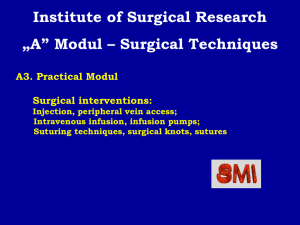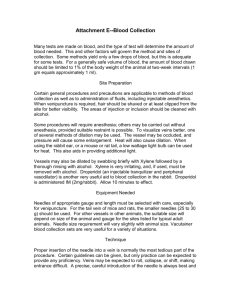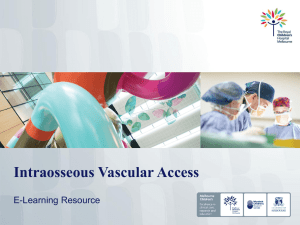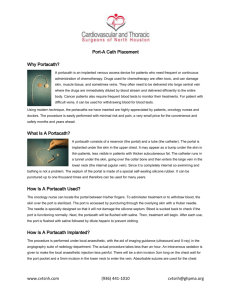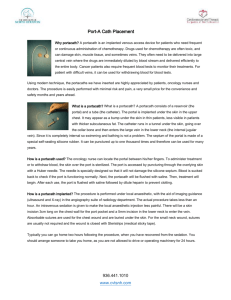Ultrasound Guided Insertion Short Peripheral IV Catheter
advertisement
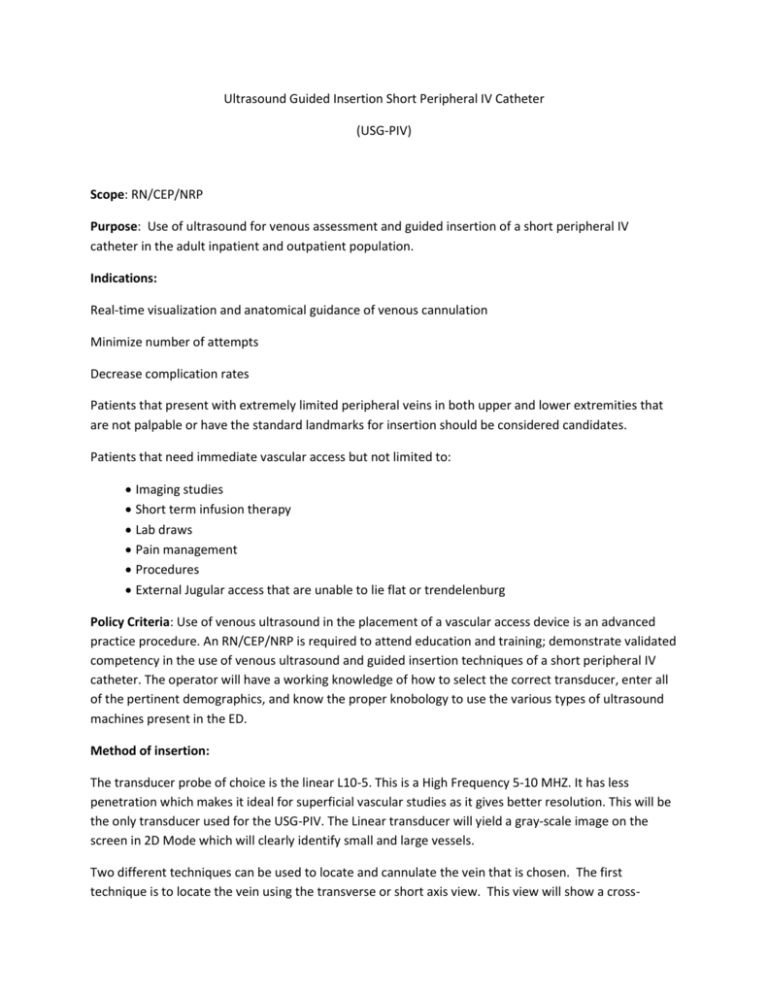
Ultrasound Guided Insertion Short Peripheral IV Catheter (USG-PIV) Scope: RN/CEP/NRP Purpose: Use of ultrasound for venous assessment and guided insertion of a short peripheral IV catheter in the adult inpatient and outpatient population. Indications: Real-time visualization and anatomical guidance of venous cannulation Minimize number of attempts Decrease complication rates Patients that present with extremely limited peripheral veins in both upper and lower extremities that are not palpable or have the standard landmarks for insertion should be considered candidates. Patients that need immediate vascular access but not limited to: Imaging studies Short term infusion therapy Lab draws Pain management Procedures External Jugular access that are unable to lie flat or trendelenburg Policy Criteria: Use of venous ultrasound in the placement of a vascular access device is an advanced practice procedure. An RN/CEP/NRP is required to attend education and training; demonstrate validated competency in the use of venous ultrasound and guided insertion techniques of a short peripheral IV catheter. The operator will have a working knowledge of how to select the correct transducer, enter all of the pertinent demographics, and know the proper knobology to use the various types of ultrasound machines present in the ED. Method of insertion: The transducer probe of choice is the linear L10-5. This is a High Frequency 5-10 MHZ. It has less penetration which makes it ideal for superficial vascular studies as it gives better resolution. This will be the only transducer used for the USG-PIV. The Linear transducer will yield a gray-scale image on the screen in 2D Mode which will clearly identify small and large vessels. Two different techniques can be used to locate and cannulate the vein that is chosen. The first technique is to locate the vein using the transverse or short axis view. This view will show a cross- section of the vessels. Once located, the operator should compress down on the vessels gently to visualize the vein collapsing. The artery is much thicker and slightly more hyperechoic and should not compress. LINEAR ARRAY TRANSDUCER L10-5 Operator may use a tegaderm to place over the transducer if blood or contamination is expected. Select the L10-5 use the push button below the monitor. Under Exam use the Vascular Icon Use Venous UE (upper extremity) for the vascular selection Enter Pt. Data and your operator ID –employee number Apply US gel and start in the transverse or short axis view to locate the vein. The probe indicator maker should be pointed left and the US machine should be to the left as well for better visualization. There should be two obvious circular structures on the screen. A vein which is ovoid in shape and a pulsating artery which is oval in shape should be identified. Once the view is obtained, click on the OPTIMIZE button to clean up the view. Fan the transducer back and forth as up and down slowly to adjust the vein in the center of the screen. You may use the DEPTH toggle key to increase or decrease the size on the screen. Cleanse the skin using the ChloraPrep Single Swabstick. Enter the skin at a 45 degree angle in the center of the transducer approx. 1.5 cm away from the transducer. Use the cm markings on the screen to estimate your needle depth. This will help prevent damage to the inferior vessel border. You will see the needle on the screen as a gray-white image. The is called “Ring Down Artifact” Guide the needle using quick, short “Jabs” to have the needle enter the lumen of the vein. May move the probe distally as the needle advances to monitor the needle tip. This is the point where it is advised to click the “Save Pic” as it gives proof of the lumen penetrated. At this point the operator should see a flash of blood in the catheter chamber, feel a pressure change on the syringe, or visualize the needle in the vein. Not all three may occur. If the operator uses the sagittal or long axis view then you will see the vessel across the screen from left to right. Use the same technique as the transverse or short axis. In long axis, you should see the actual needle tip entering the lumen and may see the normal saline flush enter the vein. The Internal Jugular Vein (IJ) rests on top of the Carotid Artery. The EJ should be above the IJ and distend with digital pressure and/or Valsalva technique. Identify the External Jugular, the Internal Jugular, and Carotid Artery. The Carotid Artery will be pulsatile and you may use the “Color” mode to see the pulsatile wave to accurately see the artery. When using the sagittal or long axis technique, the probe marker should be pointed towards the head of the patient. Use a 45 degree angle of insertion at the distal end of the probe for needle insertion. The operator can slide the probe proximally/distally to observe needle insertion into the lumen. Follow the needle on the screen to see if it enters the lumen. Transverse or short axis should reveal tip entering the lumen and a flash. Sagittal or long axis may show needle to the side of the vessel. Once again, use short, quick jabs to see the needle and to enter the vein lumen. After vein entry, secure the catheter and draw the blood specimens needed. You may visualize the normal saline flush under ultra sound as turbulence on the screen. This may be captured by clicking on the SAVE PIC button. Secure the IV as per protocol with tape and or tegaderm and document in Epic. The operator should keep a patient label and document where the US guided IV was placed for QA and competency reviews. After the completion of the procedure, the US equipment must be clean with the provided wipes. These are the ones with the red lids. Cavi wipes and alcohols pads are not to be used on the cable or the transducer. Clean the patient. WIPE OFF ALL of the US gel. Transverse Plane US Guided IV Insertion Sagittal or Long Axis approach. Qualifications: RN/CEP/NRP As initiated by the USG-PIV leadership team Initial qualification: Attend education and training. Complete appropriate educational course including but not limited to the use of the venous ultrasound machine and anatomy of the upper extremity veins, arteries, and nerves. 100% competency at the use of the US machine. 5 successful insertions observed by preceptor. MD, RN, CEP, NRP All USG-PIV will have a sticker applied into a log for QA/QI Annual Re-Qualification required One practicum at 100% with proof of (6-10) successful insertions in the previous 12 months All check-offs by designated USG-PIV qualified RN/CEP/NRP preceptor Practice Criteria for USG-PIV Assessment and insertion by a qualified RN, CEP, NRP. MD order not required. Exception: Patient was already attempted maximum number of attempts per hospital policy. Explain the procedure to patient or person (s) responsible as well as the risks/benefits. Risks: nerve damage, inadvertent arterial stick, infection, phlebitis, bruising, infiltration Benefits: less invasive, lower infection rates, less IV needle sticks, direct insertion Components of Documentation: All pertinent information in the patient’s medical record. Documentation should include the vein used, number of attempts, catheter size and length, secured method, Ultrasound used under comments, and per EPIC policy documentation. Notify MD if any complications or concerns related to procedure. Periodic IV monitoring Is required and must be documented.


